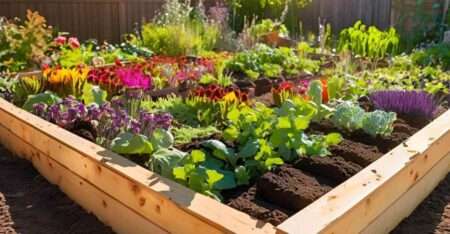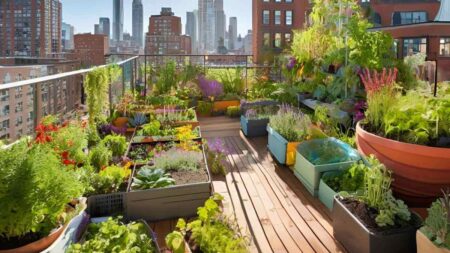Starting a fruit garden can be an exciting journey, especially for beginners who are eager to grow their own fresh and delicious produce. Whether you’re a new gardener, a hobbyist looking to expand your skills, or a city dweller hoping to create a small urban oasis, this guide is here to help. Growing fruit not only provides you with healthy food but also fosters a connection with nature and contributes to a more sustainable lifestyle. In this blog post, we’ll cover easy tips for beginners to thrive as they start their very own fruit garden.
Why Start a Fruit Garden?
For many, the idea of growing fresh, organic fruit at home is both appealing and rewarding. It offers several benefits:
- Healthier food options: Home-grown fruit is free from harmful pesticides and chemicals.
- Environmental impact: Growing your own food reduces the need for transportation and packaging, making it an eco-friendly choice.
- Sustainability: Fruit gardening is a step towards self-sufficiency and sustainability.
- Family activity: It’s a great way to involve children in learning about where their food comes from.
Whether you have a large backyard, a small patio, or a balcony, you can enjoy the satisfaction of harvesting your own fruit with the right approach.
Easy Tips to Start a Fruit Garden for Beginners
Now that you’ve decided to start your fruit garden, let’s dive into the essential tips that will ensure your success.
1. Choose the Right Fruit for Your Climate
- Relevance: Not all fruits grow well in every region, so it’s important to choose fruit varieties that thrive in your local climate.
- Research: Before planting, research which fruits are suited to your area. For example, strawberries, blueberries, and apples thrive in temperate climates, while citrus fruits like lemons and oranges are perfect for warmer, tropical regions.
- Pro Tip: Consult your local garden center or extension service for recommendations.
2. Pick the Perfect Location
- Sunlight: Most fruit-bearing plants require 6-8 hours of direct sunlight per day. Pick a location in your garden that gets adequate sunlight to promote healthy growth.
- Drainage: Ensure the area has good soil drainage. Fruits like strawberries and raspberries dislike waterlogged roots, so well-draining soil is essential.
- Space Consideration: Even in small spaces, you can still grow fruit. Consider container gardening or vertical growing techniques for plants like berries or dwarf fruit trees.
3. Start Small and Simple
- Beginner-Friendly Fruits: If you’re new to gardening, it’s best to start with fruits that are easy to grow and maintain. Strawberries, blueberries, and raspberries are all beginner-friendly options that produce fruit relatively quickly.
- Low-Maintenance Varieties: Opt for fruits that require minimal care and have fewer pest problems, such as blackberries and currants. These hardy plants are great for novice gardeners.
4. Soil Preparation and Fertilization
- Test Your Soil: The success of your fruit garden starts with healthy soil. You can purchase a home soil test kit or send a sample to your local agricultural extension to test pH levels and nutrient content.
- Amend the Soil: Most fruits thrive in slightly acidic to neutral pH soil (5.5 to 7.0). You may need to add organic matter such as compost or well-rotted manure to enrich your soil.
- Fertilize: Fruits are heavy feeders, meaning they require a lot of nutrients. Use organic fertilizers like fish emulsion or compost tea to boost growth during the growing season.
5. Watering Essentials
- Consistent Watering: Fruit plants need consistent moisture to produce juicy fruits. Water your plants early in the morning or late in the afternoon to avoid evaporation.
- Mulching: Use mulch around the base of your plants to retain soil moisture and prevent weeds. Organic mulch such as straw or wood chips is great for maintaining soil health.
- Avoid Overwatering: While watering is crucial, overwatering can lead to root rot. Ensure that the soil stays moist but not waterlogged.
6. Pruning and Maintenance
- Prune Regularly: Regular pruning helps fruit plants maintain their shape, remove dead or diseased branches, and encourage better fruit production.
- Thinning Fruits: Once your fruit plants begin producing, thin out excess fruit to ensure larger, healthier produce. For example, apples and peaches benefit from thinning to prevent the tree from becoming overloaded.
7. Protect Your Plants from Pests and Diseases
- Pest Control: Common pests like aphids, mites, and fruit flies can damage your plants. Use natural pest control methods such as neem oil, insecticidal soap, or beneficial insects like ladybugs.
- Disease Prevention: To prevent diseases like powdery mildew and root rot, avoid overcrowding your plants and ensure they have proper air circulation. You can also choose disease-resistant varieties.
How to Grow Fruit in Small Spaces
Living in a city or having limited space doesn’t mean you can’t enjoy fresh fruit from your own garden. Many fruits can be grown in containers or vertical gardens, making them ideal for patios, balconies, or small backyards.
1. Container Gardening
- Ideal Fruits for Containers: Dwarf fruit trees, strawberries, and blueberries are perfect for growing in containers. Use large pots with good drainage to give the plants enough room to grow.
- Potting Mix: Use a high-quality, well-draining potting mix and place your containers in a sunny spot.
2. Vertical Gardening
- Space-Saving Techniques: Use trellises, wall-mounted planters, or hanging baskets to grow fruits like raspberries, grapes, or strawberries vertically. This maximizes space while still providing ample growing room.
Encouraging Children to Get Involved
Fruit gardening can be a fun and educational family activity. Encourage your children to take part by:
- Letting them choose their favorite fruit to grow.
- Assigning them small tasks like watering or harvesting.
- Teaching them about the plant’s life cycle and how food is produced.
Frequently Asked Questions/FAQs
What fruits are best for beginner gardeners?
For beginner gardeners, fruits that are easy to grow and maintain include strawberries, blueberries, raspberries, and apples. These fruits are well-suited to a variety of climates and require relatively low maintenance, making them ideal for those new to gardening. Additionally, these fruits typically have fewer pest problems and are more forgiving of common gardening mistakes.
How can I start a fruit garden in a small space?
To start a fruit garden in a small space, consider container gardening or vertical gardening. Dwarf fruit trees, strawberries, and blueberries can thrive in containers, while vertical gardening techniques like trellises and wall-mounted planters can maximize space. Ensure you use high-quality potting soil and choose fruit varieties suited to container growth for the best results.
What are the essential steps for preparing soil for a fruit garden?
Preparing soil for a fruit garden involves several key steps: 1) Test the soil to check pH levels and nutrient content. 2) Amend the soil with organic matter such as compost to improve fertility and drainage. 3) Ensure the soil has good drainage to prevent waterlogging, which can harm fruit plants. 4) Fertilize according to the needs of the specific fruit plants you are growing to support healthy growth and fruit production.
Conclusion: Take Action and Start Growing!
Starting a fruit garden is an enjoyable and rewarding way to produce your own fresh, organic fruit at home. By following these easy tips for beginners, you’ll be well on your way to a thriving garden, whether you’re working with a large backyard or a small urban space.
Now is the perfect time to take action and plant your first fruit tree or berry bush. Gardening not only provides you with nutritious food but also contributes to a healthier lifestyle and a greener planet. Don’t wait—start your fruit garden today and watch it flourish!
This comprehensive guide will help new and aspiring gardeners gain the confidence to start a fruit garden and thrive with healthy, productive plants. From choosing the right fruits to understanding the essentials of watering and pest control, your fruit garden will be on the path to success in no time.
Read Also
Easiest Fruits to Grow: Start Your Simple Home Garden Today!









12 Comments
Home-grown fruit is free from harmful pesticides and chemicals.
Thank you for your easy tips to start a fruit garden.
This is a very informative and helpful post for fruit gardener.
love how this website blends home improvement and gardening advice into one cohesive platform. It’s perfect for someone like me who enjoys both aspects of home care. The content is well-organized, making it easy to find exactly what I need, whether it’s tips on plant care or advice on upgrading my living space. The attention to detail in the articles really sets this site apart from others. It’s clear that the authors are passionate about their topics and want to share their knowledge in a way that benefits everyone. I’m always excited to see new posts!
Spending time in a garden, whether tending to plants or simply enjoying the scenery, can significantly reduce stress and improve mental health. The act of gardening itself is therapeutic, offering a sense of calm and connection with nature.
Your site is so informative.thank you so much.i am waiting for the next post.
The content is well-organized, making it easy to find exactly what I need, whether it’s tips on plant care or advice on upgrading my living space. The attention to detail in the articles really sets this site apart from others. It’s clear that the authors are passionate about their topics and want to share their knowledge in a way that benefits everyone.
Innovative Ideas – “I appreciate the innovative ideas you share for small space gardening. It’s great to see solutions for those of us with limited space.
This post on low-maintenance gardening is a lifesaver! I’ve always wanted to have a garden but didn’t think I had the time. Now I’m excited to start with the plants you recommended!
I’ve been using this website as my go-to resource for all things fruit gardening. The information is clear, concise, and easy to follow. I especially appreciate the detailed guides on pruning, pest control, and selecting the right varieties for my climate. Thanks for creating such a helpful resource.
I’m really impressed with the practical tips and advice you provide on home gardening. Your recent article on growing vegetables in small spaces was exactly what I needed! It’s amazing how you make gardening accessible even for beginners like me. Looking forward to trying out more of your suggestions!
Pingback: Perfect Beet Harvesting: Easy Tips for a Bountiful Garden Crop